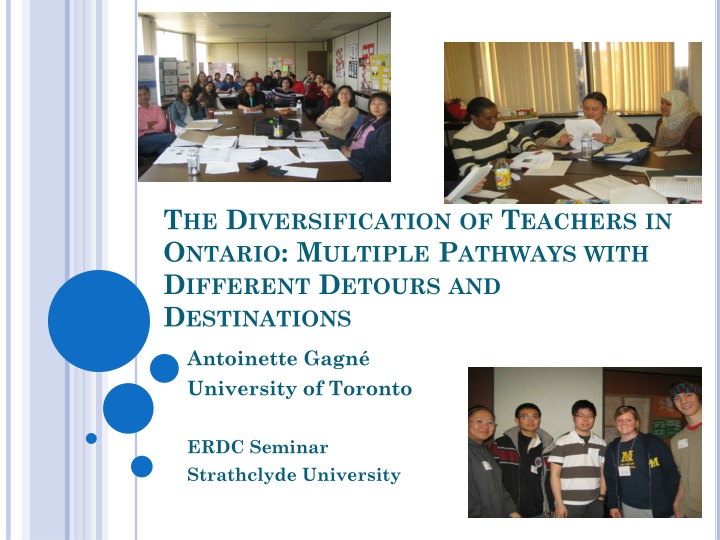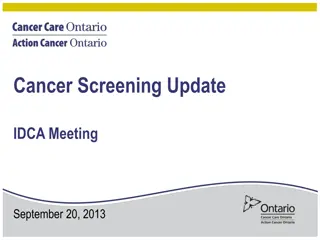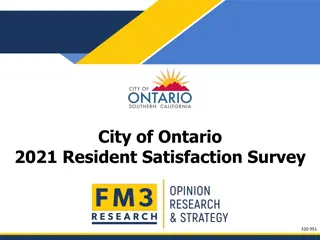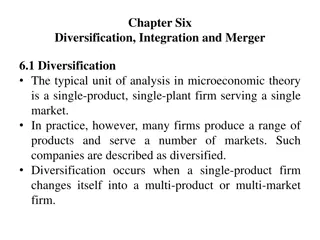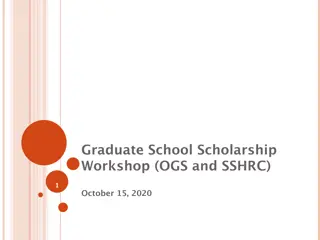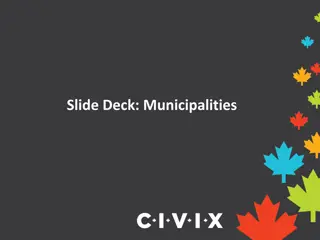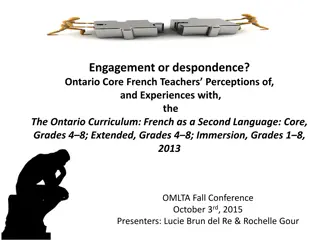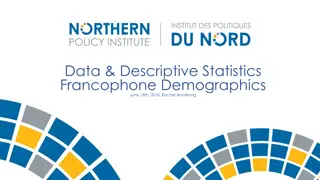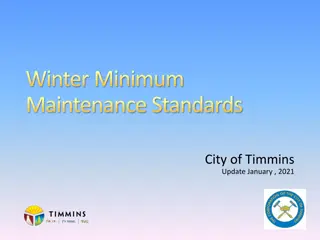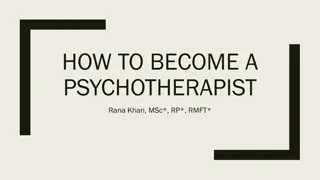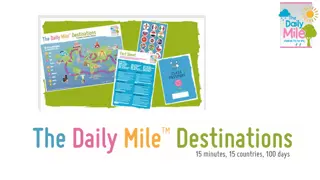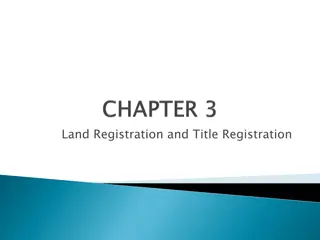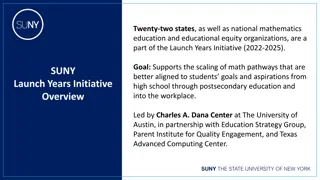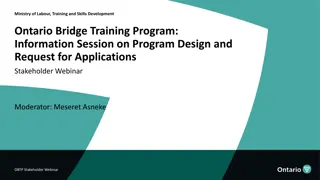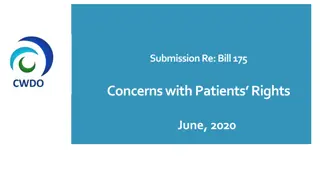THE DIVERSIFICATION OF TEACHERS IN ONTARIO: MULTIPLE PATHWAYS WITH DIFFERENT DETOURS AND DESTINATIONS.
Exploring the diversification of teachers in Ontario through various pathways, including the impact of Canadian immigration policies, admission policies at the University of Toronto, and challenges faced by internationally educated teachers (IETs). The evolving demographic trends of immigrants in Ontario, teacher shortages, and initiatives to address certification processes are highlighted. Government and institutional support for IETs aiming to teach in Ontario are discussed.
Download Presentation

Please find below an Image/Link to download the presentation.
The content on the website is provided AS IS for your information and personal use only. It may not be sold, licensed, or shared on other websites without obtaining consent from the author.If you encounter any issues during the download, it is possible that the publisher has removed the file from their server.
You are allowed to download the files provided on this website for personal or commercial use, subject to the condition that they are used lawfully. All files are the property of their respective owners.
The content on the website is provided AS IS for your information and personal use only. It may not be sold, licensed, or shared on other websites without obtaining consent from the author.
E N D
Presentation Transcript
THE DIVERSIFICATIONOF TEACHERSIN ONTARIO: MULTIPLE PATHWAYSWITH DIFFERENT DETOURSAND DESTINATIONS Antoinette Gagn University of Toronto ERDC Seminar Strathclyde University
OVERVIEW Various pathways leading to the diversification of the teaching force in Ontario The impact of Canadian immigration policies on teacher demographics in Ontario The admissions and program policies of the University of Toronto The policies and research of the Ontario College of Teachers Other Ontario based research on IETs Issues
IMMIGRATIONTO CANADA PRIORTO 1981 ANDAFTER 2001 Top 10 source countries for immigrants coming to Canada up until 1981: United Kingdom The Top 10 countries of origin for immigrants to Canada between 2001 and 2006: China - 155,105 Italy India - 129,140 U.S. Philippines - 77,880 Germany Pakistan - 57,630 Portugal United States - 38,770 Netherlands South Korea - 35,450 India Romania - 28,080 Poland Iran - 27,600 China United Kingdom - 25,655 Countries of the former Yugoslavia Colombia - 25,310
THE ONTARIO CONTEXT 2000 - 2011 Most immigrants before 1981 blended in with the majority Caucasian population of the time Today the majority of immigrants in the last two decades are visible minorities About 140,000 immigrants arrive in Ontario each year These newcomers come from a wide range of countries and many do not speak English 2000-2006 Teacher shortage especially in Math, Chemistry, Physics, Computer Studies and French 2000-2004 IETs face considerable challenges in the process of becoming certified to teach in Ontario 2004 The Teach in Ontario Initiative is launched 2006 Essential Skills profiles for elementary and secondary teachers are drafted 2007 The teacher shortage is declared officially over except in the high demand areas 4
THE ONTARIO CONTEXT Several government and institutional websites include information for IETs wanting to teach in Ontario. For example the Ontario College of Teachers website and the Ministry of Citizenship and Immigration Of the more than 1600 applications received annually from IETs who have completed teacher training from more than 100 jurisdictions outside Ontario about half are immigrants Census data shows that each year several hundred landed immigrants indicate that teaching in their intended profession 5
HIGH LEVELSOFIMMIGRATIONLEADTOTHE DIVERSIFICATIONOFTEACHERCANDIDATES The high levels of immigration the Greater Toronto Area has experienced in the last 20 years has led to an increase in the diversity of the pool of applicants to Ontario faculties of education and in particular to 5-year initial teacher education programs to which high school graduates can apply. Proactive admissions policies in Ontario faculties of education have also led to a greater number of applicants from diverse backgrounds being admitted to all initial teacher education programs.
STRATEGIESTO ADDRESS TEACHER SHORTAGEINONTARIO For several years, in the early 2000s, the Canadian Government posted lists of preferred occupations for immigrants which included elementary and secondary school teachers. As a result, the number of internationally educated teachers (IETs) applying to the Ontario College of Teachers (OCT) to have their credentials recognized increased greatly. The shortage of teachers in Ontario was addressed by increasing the number of positions in initial teacher education programs across Ontario and establishing services and supports for the orientation and recertification of IETs.
TEACHIN ONTARIOBRIDGING PROGRAM Discussions about the importance of a teaching force that was more reflective of the children attending elementary and secondary schools began during the teacher shortage. Teacher unions, the Ontario College of Teachers, faculties of education and urban school districts were involved in developing the Teach in Ontario Initiative. Teach is Ontario was a bridging project for teachers funded by the Government of Ontario and the Government of Canada through Citizenship and Immigration Canada. The purpose of the project was to help internationally educated teachers navigate the certification process and prepare for employment as teachers in Ontario.
BRIDGING PROJECTENDED As ofJuly 1, 2009, when the teacher shortage was officially over , Teach in Ontario no longer offered services to support internationally educated teachers. Although the project has ended, information about the certification and employment preparation processes continues to be available online http://www.teachinontario.ca/ and http://www.oct.ca/IET/.
PREFERRED ADMISSIONS CATEGORYFOR IETS The involvement of Faculties of Education in the Teach in Ontario project, led to the creation of a preferred admissions category for Internationally Educated Teachers. Many immigrant teachers find out from the College of Teachers that their credentials are not recognized in Canada and that it is necessary for them to return to a Faculty of Education and enroll in an initial teacher education program. At several of the larger faculties of education, such an admissions category exists. For example, at the University to Toronto, where admission to the initial teacher education program is very competitive, the IET admission category was created to assist new Canadians with international teaching experience to integrate into the teaching profession in Ontario. http://www.oise.utoronto.ca/ro/BEd_Tech_Admissions/Thinking_of_Applying/BEd_Admissions_Guide/ Internationally_Educated_Teachers.html
SUPPORTFOR INTERNATIONALLY EDUCATED TEACHER CANDIDATESATTHE UNIVERSITYOF TORONTO There are also a range of special support services and programs in place to help IETs who are registered at the University of Toronto. These include a Pre-field Experience which is a practicum deferral option and the Academic and Cultural Support Centre (ACSC) which is an integrated service provider for graduate students and teacher candidates studying at OISE. The ACSC has been central in pulling together several programs to support internationally educated teacher candidates (IETCs) to succeed in their teacher education programs. The ACSC is a full-service academic and cultural communication resource and support centre.
WHATWEDOTOSUPPORTINCLUSION ATTHE UNIVERSITYOF TORONTO Before initial teacher education Recruitment Admissions During initial teacher education Careful design of program components Programmatic supports
OISE/UT POLICYON EQUITYAND DIVERSITY - EXCERPT OISE/UT admits significant numbers of teacher candidates each year. As such, it is one of the principal sites where education about diversity and equity issues are addressed. Through our teaching OISE/UT has immediate and direct effects on the ongoing work of teacher candidates. To further ensure that social justice prevails in our programs we will aim to: enrol and support a student body that reflects the diversity of the communities we serve through, for example, processes for student recruitment, selection, admission and subsequent support and accommodations; ensure that social justice is promoted in all areas of our curriculum, in our pedagogy, in the climate of our classrooms, and in all aspects of the OISE/UT environment; hire and support individuals who have a demonstrated commitment and capacity to realize our social justice goals through their work and community involvement. http://www.oise.utoronto.ca/oise/About_OISE/Policies.html
DURING: RESPONSIVEAND DIFFERENTIATED PROGRAMMING Multiple pathways to teaching Work with Accessibility Services and Student Services to ensure appropriate accommodations and scaffolding to allow candidates to meet program requirements Transitions program ESL Infusion The Academic and Cultural Support Centre
THE OISE ACADEMICAND CULTURAL SUPPORT CENTRE The ACSC offers: One-on-one support with oral and written communication skills as well as aspects of classroom and school culture in person, by telephone or email Language & culture workshops Observation days in schools Teaching support programs http://www.oise.utoronto.ca/ss/Academic_Cultural_Support_at_OISE/index.html 20
ACADEMICAND CULTURAL SUPPORT CENTRE The Centre provides help with: Academic Writing (planning, organizing, writing, and revising academic papers such as essays, web/article reviews, lesson plans, portfolios, personal journal entries, etc.) English Language Proficiency Improvement (grammar, oral communication, listening, reading, etc.) Oral Presentations (in-class presentations, conference presentations, lesson delivery, etc.) http://www.oise.utoronto.ca/ss/Academic_Cultural_Support_at_OISE/index.html 21
ACADEMICAND CULTURAL SUPPORT CENTRE The Centre provides help with: R sum s and Cover Letters (for pre-service students applying to Boards of Education) Insights into the Culture of K-12 Schools in Canada Strategies for Success in Teacher Preparation and Graduate Programs at OISE/UT (time management, goal setting, dealing with culture shock, etc ) Intercultural communication skills for Canadian K-12 classrooms http://www.oise.utoronto.ca/ss/Academic_Cultural_Support_at_OISE/index.html 22
PREP (PRE-FIELD EXPERIENCE PROGRAM) FOR IMMIGRANT CANDIDATES PREP is a non-evaluated but feedback-rich alternative to the first practicum, specifically designed for internationally educated teacher candidates. This program integrates intensive workshops, school placements that include observations and practice teaching in the Toronto District School Board. http://www.oise.utoronto.ca/ss/Academic_Cultural_Support_at_OISE/index.html 23
SPECIFICCOURSESAND PRACTICUMFOR IETS Several universities also offer specific courses and a practicum for IETs who need to take just one or two courses or a practicum. For example, Continuing Education at OISE offers practicum placements and assessments held in classrooms across the Greater Toronto Area to support the growing understanding and expertise of IETs within the Ontario educational system. Internationally educated teachers who have received an official letter from the Ontario College of Teachers detailing requirements for certification and registration, attend a small group orientation and counseling session to find out about courses in education, additional basic qualifications and the practicum.
ESSENTIAL SKILLS PROFILESFOR PROFESSIONALSIN EDUCATION Ever increasing immigration and the demand for a highly skilled labour force has led the Canadian Government to develop Essential Skills profiles which describe how each of the nine Essential Skills are used by workers in a particular occupation. Over the past several years, the Government of Canada has conducted extensive research examining the skills people use in the workplace. These include more than five which outline the skills required by teachers across various contexts. These profiles are useful guides for immigrant teachers and those who support them in their transition back to teaching in Ontario.
ESSENTIAL SKILLS PROFILES Elementary School and Kindergarten Teachers Secondary School Teachers Educational Counselors Early Childhood Educators and Assistants Instructors and Teachers of People with Disabilities Other Instructors http://www.rhdcc-hrsdc.gc.ca/eng/workplaceskills/essential_skills/general/home.shtml
TRANSITIONTO TEACHING STUDY The Ontario College of Teacher surveys new teachers each year as part of their Transition to Teaching research. In its sixth year, the Transition to Teaching study surveyed new Ontario teachers initially certified in other jurisdictions. This survey included three distinctly different groups of respondents. One in four respondents (26%) was a new Canadian who immigrated to Ontario from outside Canada following their teacher education and/or a teaching career elsewhere. About half (53 per cent) were Ontarians who did their teacher education in another province or country. The remaining 21 % migrated to Ontario from another province in which they completed their teacher education programs. http://professionallyspeaking.oct.ca/march_2010/featu res/transition.aspx
TRANSITIONTO TEACHING STUDY New-Canadian teachers have faced very high levels of unemployment and underemployment throughout the 6 years they have been included in this study. In 2008-2009, immigrant teachers continued to be considerably less successful than Ontario faculty graduates in getting teaching positions. The Ontario College of Teacher licenses 1,500 to 1,700 internationally educated teachers annually, about half of whom are new-Canadians. http://professionallyspeaking.oct.ca/march_2010/f eatures/transition.aspx
TRANSITIONTO TEACHINGFOR CERTIFIED IETS New teachers who immigrate to Canada face a particularly challenging job market that, for most of them, means an initial year of unemployment or significant underemployment in teaching. Very few new-Canadian teachers find jobs in Ontario district school boards in today s competitive teacher- employment market. Only 3% of the immigrant teachers responding to the Transition to Teaching survey said they were successful in finding regular teaching jobs in publicly funded Ontario school boards in the 2008-2009 school year. http://professionallyspeaking.oct.ca/march_2010/features/t ransition.aspx
TRANSITIONTO TEACHING STUDY This compares with 15 % for the Ontario faculty of education graduates of 2008. More than 36% of the new-Canadians were unable to find teaching employment of any type and over 52 % report they were underemployed in their first year of actively seeking teaching employment in Ontario. Despite taking the first step of securing Ontario recognition of their teaching credentials, most new-Canadian teachers face significant challenges in establishing themselves in their profession in this province. http://professionallyspeaking.oct.ca/march_2010/featu res/transition.aspx
TRANSITIONTO TEACHING STUDY The employment situation for first-year new- Canadian teachers in the 2008-09 school year was somewhat better than for this teacher group in the two preceding school years. Their unemployment and underemployment rates improved somewhat in 2008-09. The improvements, however, are reflected mainly in more long term occasional teaching and teaching outside the publicly funded school systems. Regular teaching jobs, especially in publicly funded schools did not increase for immigrant teachers in 2008-2009. http://professionallyspeaking.oct.ca/march_2010/featu res/transition.aspx
TRANSITIONTO TEACHING STUDY Most of these underemployed teachers have many years of teaching experience More than 35 % taught for more than 10 years in other jurisdictions prior to their Ontario teacher certification 60 % taught for more than 5 years 80 % have two or more years of teaching experience http://professionallyspeaking.oct.ca/march_2010/f eatures/transition.aspx
IET FOCUSSED RESEARCHATTHE UNIVERSITYOF TORONTO Antoinette Gagn , 2006 Perspectives on the Language and Cross-Cultural Support Needs of New Canadian and Non-Native English Speaking (NNES) Teachers Mira Gambhir, 2004, Non-native speakers of English in a Canadian teacher education program : needs, experiences, and policies.
IET FOCUSSED RESEARCHATTHE UNIVERSITYOF TORONTO Farahnaz Faez, 2007, Preparing diverse teachers for diverse students : perceptions of linguistic identity, experiences and teaching responsibilities in a Canadian teacher education program Odilia Ng, 2006, Narrative beyond teaching: Inquiry into the shifting identity, culture and professional practice of 5 visible minority immigrant teachers in a diverse lifespace
IET FOCUSSED RESEARCHATTHE UNIVERSITYOF TORONTO Amir H. Soheili-Mehr, Immigrant Nonnative English Speaking Teachers: The Development Of Professional Identity Fengjuan Zhang, 2005, Charting their course : nonnative-English-speaking teachers working in adult ESL programs in Canada
IET FOCUSSED RESEARCHATTHE UNIVERSITYOF TORONTO Fung Ping Deters, 2009, Identity, agency, and the acquisition of professional language and culture : the case of internationally educated teachers and college professors in Ontario Kangxian Zhao, 2011, Internationally Educated Teachers:Transition, Integration, Stress, and Coping Strategies You can locate MA and Ph.D theses by searching the OISE Library at http://www.library.utoronto.ca/oise/
MULTIPLE PATHWAYSAND DIFFERENT DESTINATIONS This brief overview of the current situation in Ontario reveals that the children of immigrants as well as immigrants who attend at least part of their elementary and secondary education in Ontario help to diversify the teaching force in Ontario while faring well in the job market. On the other hand, although immigrant teachers contribute to creating a more representative workforce, they are much less successful in obtaining employment in education.
A NEW FORUMTHE DIVERSITYIN TEACHING WEBSITE -- A SNEAKPREVIEW
